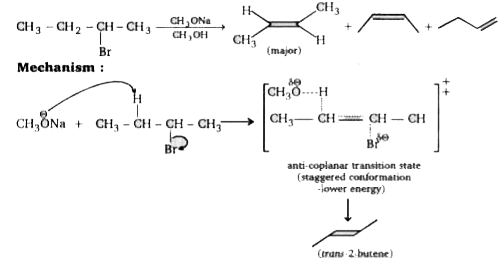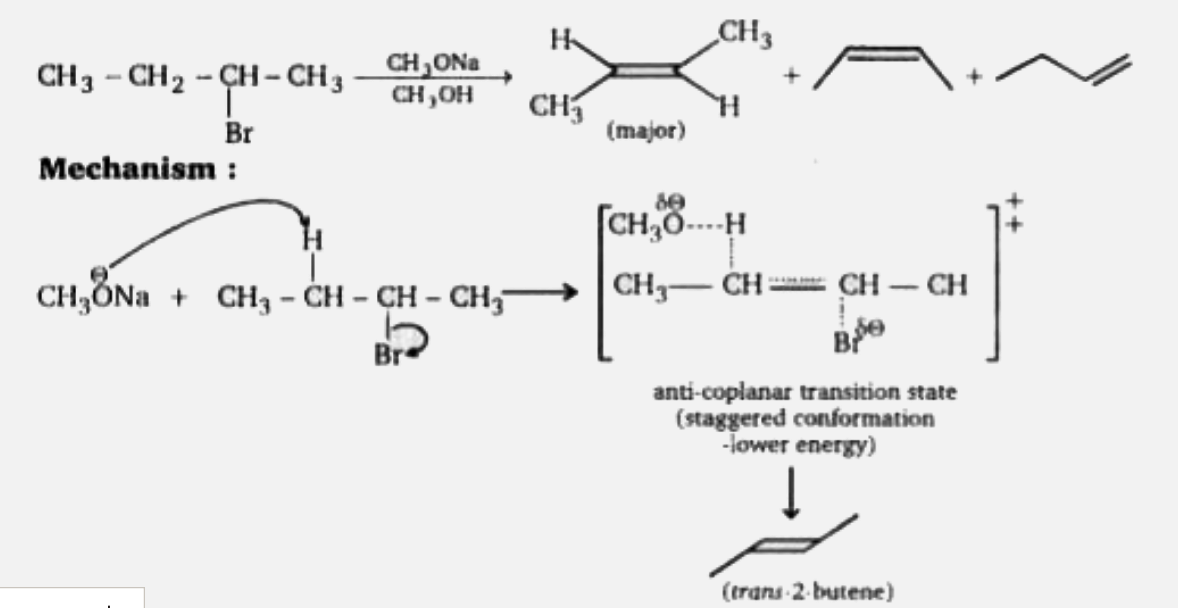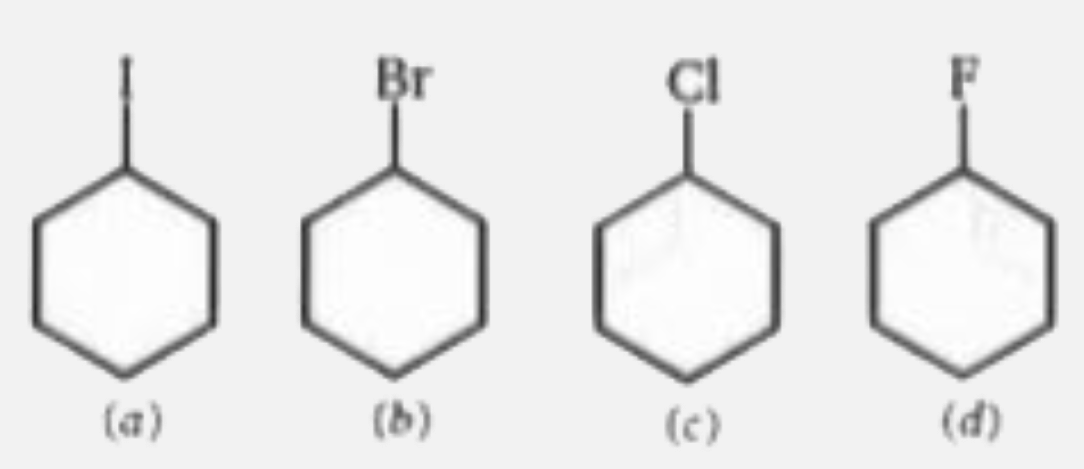Comprehension
E2 raction → Elimination bimolecular
In the general mechanism of the E2 reaction a strong base abstract a proton on a carbon atom adjacent to the one of the leaving group. As the abstracts a proton , a double bond forms and the leaving group leaves. 
 Product (A) and (B) are : Solution in Telugu
Product (A) and (B) are : Solution in Telugu
A = cis, B = cis
A = trans, B= cis
A= trans, B = trans
A = cis, B= trans
Consider conformer.
Topper's Solved these Questions
- ALKYL HALIDES (ELIMINATION REACTION) BOOK - MS CHOUHANCHAPTER - ALKYL HALIDES (ELIMINATION REACTION) EXERCISE - LEVEL-2
25 Videos
- ALDEHYDES AND KETONESBOOK - MS CHOUHANCHAPTER - ALDEHYDES AND KETONESEXERCISE - LEVEL-2
20 Videos
- ALKYL HALIDES (SUBSTITUTION REACTIONS)BOOK - MS CHOUHANCHAPTER - ALKYL HALIDES (SUBSTITUTION REACTIONS)EXERCISE - LEVEL-2
41 Videos
Similar Questions
Comprehension
E2 raction → Elimination bimolecular
In the general mechanism of the E2 reaction a strong base abstract a proton on a carbon atom adjacent to the one of the leaving group. As the abstracts a proton , a double bond forms and the leaving group leaves.

Identify the rate ofreaction of given compounds in E2 reaction:

View SolutionSelect the best choice for example (A to L) from the examples (a to n) given below. Write your choice in the box given.


View SolutionThe order of the nucleophilicity of F−,Cl−,Br−andI− in protic solvents is
View SolutionAssertion: In the E_(2) elimination beta-H and leaving group should be antiperiplanar Reason In the E_(2) elimination base always abstracts unhindered beta-H .
View SolutionE_(2) reaction to Elimation bimoleculaar in the general mechanism of the E_(2) reaction a sroeng base abstract a proton ,a double bond forms and the leaving group leaves Identify the rate for reaction of given compounds in E_2 reaction :
View SolutionThe removal of two atoms or groups one generally hydrogen (H^(+)) and the other a leaving group (L^(-)) resulting in the formation of unsaturated compound is known as elimination reaction. In E_(1) (elimination) reactions the C-L bond is broken heterolytically (in step 1) to form a carbocation (" as in "S_(N^(1)) reaction) in which (L^(-)) is lost (rate determining step). The carbocation (in step 2) loses a proton from the beta- carbon atom by a base (nucleophile) to form an alkene. E_(1) reaction is favoured in compounds in which the leaving group is at secondar (2^(@)) or tertiary (3^(@)) Position. In E_(2) (elimination) reactions two sigma bonds are broken and a pi- bond is formed simultaneously. E_(2) reactions occur in one step through a transition state. E_(2) reactions are most common in haloalkanes (particulary 1^(@) ) and better the leaving group higher is the E_(2) reaction. In E_(2) reactions, both the leaving groups should be antiplaner. E_(1) cb (Elimination unimolecular conjugate base) reaction involves the removal of proton by a conjugate base (step 1) to produce carbanion which loses a leaving group to form an alkene (step 2) and is a slow step 2-Bromonbutane on heating with concentrated solution of alcoholic KOH gives major product as :
View SolutionThe removal of two atoms or groups one generally hydrogen (H+) and the other a leaving group (L−) resulting in the formation of unsaturated compound is known as elimination reaction.

In E1 (elimination) reactions the C-L bond is broken heterolytically (in step 1) to form a carbocation ( as in SN1 reaction) in which (L−) is lost (rate determining step). The carbocation (in step 2) loses a proton from the β− carbon atom by a base (nucleophile) to form an alkene. E1 reaction is favoured in compounds in which the leaving group is at secondar (2∘) or tertiary(3∘) Position.
In E2 (elimination) reactions two sigma bonds are broken and a π−bond is formed simultaneously.E2 reactions occur in one step through a transition state.

E2 reactions are most common in haloalkanes (particulary 1∘) and better the leaving group higher is the E2 reaction. In E2 reactions, both the leaving groups should be antiplaner.
E1cb (Elimination unimolecular conjugate base) reaction involves the removal of proton by a conjugate base (step 1) to produce carbanion which loses a leaving group to form an alkene (step 2) and is a slow step
R2CH−C∣X−R2'+:B−(base)→R2C=CR2
+H−B+X−
this reaction is an example of:
View SolutionThe removal of two atoms or groups one generally hydrogen (H^(+)) and the other a leaving group (L^(-)) resulting in the formation of unsaturated compound is known as elimination reaction. In E_(1) (elimination) reactions the C-L bond is broken heterolytically (in step 1) to form a carbocation (as in S_(N^(1)) reaction) in which (L^(-)) is lost (rate determining step). The carbocation (in step 2) loses a proton from the beta- carbon atom by a base (nucleophile) to form an alkene. E_(1) reaction is favoured in compounds in which the leaving group is at secondar (2^(@)) or tertiary (3^(@)) Position. In E_(2) (elimination) reactions two sigma bonds are broken and a pi- bond is formed simultaneously. E_(2) reactions occur in one step through a transition state. E_(2) reactions are most common in haloalkanes (particulary 1^(@) ) and better the leaving group higher is the E_(2) reaction. In E_(2) reactions, both the leaving groups should be antiplaner. E_(1) cb (Elimination unimolecular conjugate base) reaction involves the removal of proton by a conjugate base (step 1) to produce carbanion which loses a leaving group to form an alkene (step 2) and is a slow step 2-Bromopentane is heated with potassium ethoxide in ethanol. The major product obtained is :
View SolutionThe elimination reactions mainly involve three mechanism E1,E2 and E1cB. If the leaving group departs before beta -proton ( H^Theta ion) then it is E1 mechanism. If proton is taken off first before leaving group it is E1cB mechanism.The pure E2 involves both beta -Hydrogen and leaving group departing simutaneously. If acidity of beta -Hydrogen increases and leaving group ability decreases then E1cB mechanism increases. Product P is
View SolutionThe elimination reactions mainly involve three mechanism E1,E2 and E1cB. If the leaving group departs before beta -proton ( H^Theta ion) then it is E1 mechanism. If proton is taken off first before leaving group it is E1cB mechanism.The pure E2 involves both beta -Hydrogen and leaving group departing simutaneously. If acidity of beta -Hydrogen increases and leaving group ability decreases then E1cB mechanism increases. The alkene formed as a major product in the above elimination reaction is
View SolutionThe elimination reactions mainly involve three mechanism E1,E2 and E1cB. If the leaving group departs before β-proton (Ht=Θ ion) then it is E1 mechanism. If proton is taken off first before leaving group it is E1cB mechanism.The pure E2 involves both β-Hydrogen and leaving group departing simutaneously. If acidity of β-Hydrogen increases and leaving group ability decreases then E1cB mechanism increases.
Which of the following substrate will undergo fastest reaction through E1cB route
View SolutionAssertion: In the E2 elimination, β−H and leaving group should be antiperiplanar.
Reason: In the E2 elimination, base always abstracts unhindered β−H.
View SolutionIn elimination reactions, generally atoms or groups from adjacent carbon atoms in the substrate molecule are removed and a multiple bond is formed
View SolutionThe elimination reactions mainly involve three mechanism E1,E2 and E1cB. If the leaving group departs before beta -proton ( H^Theta ion) then it is E1 mechanism. If proton is taken off first before leaving group it is E1cB mechanism.The pure E2 involves both beta -Hydrogen and leaving group departing simutaneously. If acidity of beta -Hydrogen increases and leaving group ability decreases then E1cB mechanism increases. Product P is
View SolutionThe elimination reactions mainly involve three mechanism E1,E2 and E1cB. If the leaving group departs before beta -proton ( H^Theta ion) then it is E1 mechanism. If proton is taken off first before leaving group it is E1cB mechanism.The pure E2 involves both beta -Hydrogen and leaving group departing simutaneously. If acidity of beta -Hydrogen increases and leaving group ability decreases then E1cB mechanism increases. The alkene formed as a major product in the above elimination reaction is
View SolutionThe elimination reactions mainly involve three mechanism E1,E2 and E1cB. If the leaving group departs before beta -proton ( H^t=Theta ion) then it is E1 mechanism. If proton is taken off first before leaving group it is E1cB mechanism.The pure E2 involves both beta -Hydrogen and leaving group departing simutaneously. If acidity of beta -Hydrogen increases and leaving group ability decreases then E1cB mechanism increases. Which of the following substrate will undergo fastest reaction through E1cB route
View Solution
